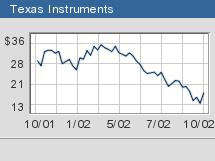NEW YORK (CNN/Money) - Texas Instruments warned Monday that fourth-quarter sales and profits would fall far short of Wall Street forecasts as demand for its semiconductor products continues to sag.
The chipmaker logged a third-quarter profit of 11 cents a share, beating analysts' estimates by a penny a share, on revenue of $2.25 billion. That compares with a loss of 3 cents a share on revenue of $1.85 billion a year earlier.
But TI also said it expects fourth-quarter revenue to fall 10 percent from the third quarter, and that earnings excluding one-time items are expected to be 2 cents a share.
At last count, the consensus estimate of analysts polled by earnings tracker First Call was for a fourth-quarter profit of 11 cents a share on revenue of $2.32 billion, suggesting a modest improvement over the third quarter.

Executives of TI, the No. 1 supplier of digital signal processors (DSPs) and analog semiconductors, said the weakness is primarily in demand for chips used in personal computers and PC peripherals. At the same time, they said demand for chips used in wireless communications products remains strong.
TI is one of the leading suppliers of components to cell phone manufacturers, and its chips are used in roughly two-thirds of the world's mobile phones.
"Wireless should continue to contribute solid growth in the fourth quarter, but this growth is expected to be more than offset by weakness in the PC and PC peripherals markets," Bill Aylesworth, TI's chief financial officer, said on a conference call.
In addition, Aylesworth said TI will aggressively cut expenses, including cutting 500 jobs in the coming months, with most of the cuts affecting employees in manufacturing and support positions.
TI (TI: Research, Estimates) lagged a broader rally among chip stocks ahead of the earnings report Monday as some company watchers weighed in with concerns about TI's business forecast for the fourth quarter.
But even the most pessimistic had expected at least a modest improvement in revenue during the fourth quarter, and the stock fell nearly 16 percent to $14.40 in extended-hours trade after closing at $17.12 on the New York Stock Exchange ahead of the earnings release.
"It's worse than the most bearish forecast, and certainly a surprise," said Eric Gomberg, semiconductor analyst at Thomas Weisel Partners.
Gomberg said he had thought strength in TI's wireless business would have been enough to offset weakness elsewhere. But the company's fourth-quarter outlook suggests that the broader semiconductor industry is continuing to struggle.
"This is a significant data point and fairly representative of the tone of business in semiconductors right now, despite the fact that we've seen a meaningful run in many of the stocks in the group," he said.
Thomas Weisel Partners does not list TI among its investment banking clients, and the firm rates the stock a "market perform."
TI's latest business forecast is the latest blast of bad news about demand for electronics, especially PCs, during the upcoming holiday season.
Executives of Intel (INTC: Research, Estimates), the No. 1 supplier of PC microprocessors, earlier this month reported a quarterly profit that missed expectations and lowered the bar for coming months, saying they expect a lackluster seasonal pickup in sales relative to prior years.
Chipmakers Advanced Micro Devices (AMD: Research, Estimates) and National Semiconductor (NSM: Research, Estimates) also recently have lowered their fourth-quarter targets. Several industry research firms recently have scaled back their forecasts as well.
With the exception of wireless, TI's orders were generally weaker in the third quarter compared with the second quarter, leading it to forecast the sharp revenue decline, Aylesworth said.
During the third quarter, TI logged total orders of $2.12 billion, down 7 percent from the second quarter but up 29 percent from the year-ago period. Semiconductor orders of $1.77 billion were down 5 percent sequentially and increased 36 percent from the year-ago period.
Aylesworth said TI's core DSP and analog businesses each logged more than 30 percent revenue growth compared with a year ago. Combined, they comprise more than 70 percent of TI's total semiconductor revenue.

|

